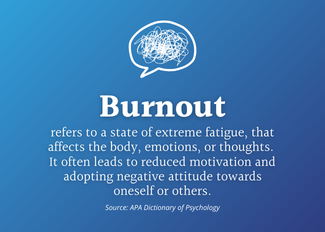As the holiday season winds down and many people transition back to work from time off, it becomes increasingly important to prioritize our mental well-being. One of the challenges that may emerge during our return to work is burnout, a psychological phenomenon characterized by “extreme fatigue, that affects the body, emotions, or thoughts” (APA Dictionary of Psychology).
Burnout is a common condition most often caused by work-related stress, and reportedly impacts over 42% of full-time desk-based workers (Future Forum). However, it can also result from other chronic stressors in various life domains like parenting, caregiving, or relationships. Recognizing and navigating burnout effectively can significantly aid in better managing mental health during what is often a transitional period, as well as in building resilience for the year ahead.
How do I recognize burnout?
Identifying burnout comes with an awareness of its three common warning signs. The first is experiencing intense fatigue despite having sufficient rest and sleep. The second main symptom involves feeling cynical and numb about your work and social interactions. Lastly, the third warning sign encompasses negativity, difficulty concentrating, and/or apathy towards daily tasks. Other signs of burnout might manifest as feelings of overwhelm or even physical symptoms such as tension headaches or changes in diet or sleep patterns.
Is burnout the same as depression?
Though burnout and depression share similarities in symptoms like intense fatigue, demotivation, and social withdrawal, they are distinct psychological conditions with differing causes. Burnout results from external stressors within an individual’s environment, such as work or caregiving commitments. On the other hand, depression is a clinical condition that stems from multifaceted factors, including life events, changes in the brain, and personal factors such as medical history and genetics. Thus, navigating burnout requires a unique approach distinct from addressing depression.
I think I’m burnt out, what next steps should I take?
Combatting burnout looks different for each person due to individual needs and circumstances. Identifying external triggers and re-evaluating life responsibilities and self-care needs can be a good starting point. This can be as simple as asking to share some tasks with your colleagues and support network, or scheduling a weekly activity that can help to recharge you. Consulting with a therapist, trusted loved one, or helpline may also be helpful.
When navigating burnout, asking yourself specific questions like these can prove helpful:
- Are there specific work-related or environmental factors contributing to my feelings of burnout?
- Are there particular situations or relationships that consistently drain my energy?
- Can I delegate or share some of my tasks with colleagues or my support networks?
- Am I prioritizing adequate sleep and restful downtime?
- Can I postpone or eliminate some of my commitments temporarily?
- How can I allocate time to activities that recharge me, such as exercise, meditation, socializing, and other hobbies?
- Have I talked about this with a therapist, trusted loved one, or helpline? If I haven’t, would I find this to be helpful?
- What stress-relief strategies have worked for me in the past? Are there any new strategies I’m willing to try out?
Reaching Out
Feeling unable to continue due to burnout is a valid experience that deserves attention. Taking steps to address burnout isn’t a sign of weakness but rather a demonstration of strength. Everyone deserves to feel capable and well. If you’re looking for someone to talk to in order to navigating your feelings of burnout or more, please find below 24/7 helplines and MHA’s Community Connection line, all staffed by trained professionals:
- Crisis Text Line: The Crisis Text Line is a global nonprofit organization providing free and confidential text-based mental health support and crisis intervention by texting HOME to 741741. Its services are available 24 hours a day.
- 988 Lifeline: The 988 Suicide & Crisis Lifeline provides immediate crisis assistance and is also a resource for information and consultation. Trained individuals staff this hotline 24 hours each day, every day of the year, and assistance is available in multiple languages.
- MHA Community Connection Line: If you just need someone to talk to, consider calling our Community Connection line at 914-349-5900 x7101. MHA's Community Connection Line is available to all community members - at no cost - and is staffed by credentialed professionals Monday through Friday, from 9:00 a.m. to 5:00 p.m.
Follow us on Instagram (@mhawestchester) or @ The Mental Health Association of Westchester on LinkedIn or Facebook for more insights on burnout and other mental health tips and news.

